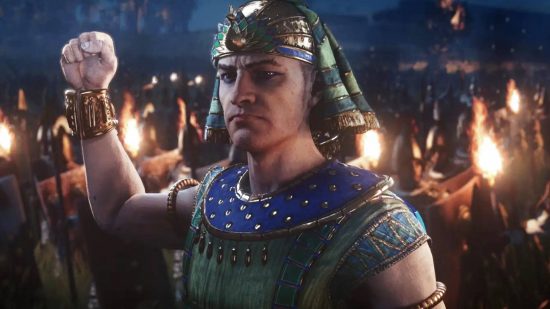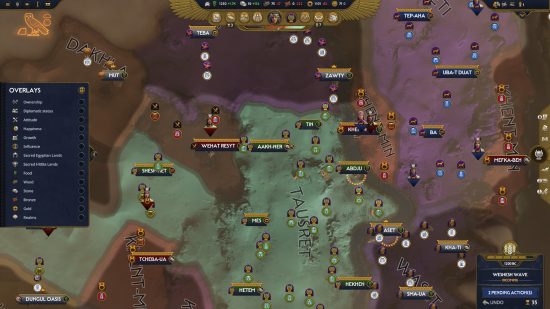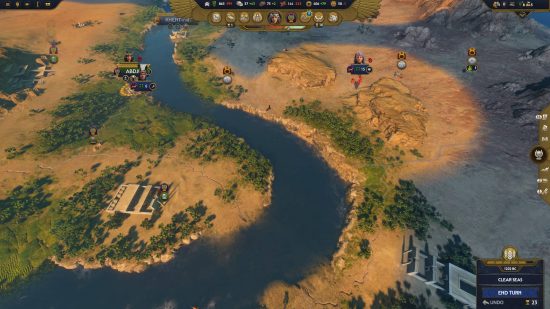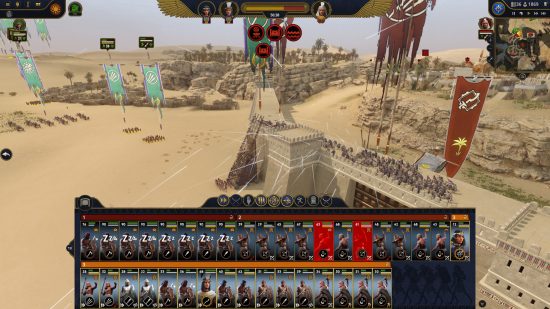It can be easy to forget just how much research goes into making each new entry to the Total War series, especially with over two decades of the historical strategy games released to date. While many players are more concerned with the design of a new Total War’s battlefield tactics and strategic possibilities, a release like this month’s Total War: Pharaoh requires its creators to spend just as much effort digging into the history of its setting as any other aspect of the game’s creation.
In an email interview with PCGamesN, Total War: Pharaoh game director Todor Nikolov explains that his team’s research underlies even the first steps of making a game. Developer Creative Assembly Sofia, the studio behind Total War Saga: Troy and a pair of Total War: Rome II expansions, knew that it wanted to make a strategy game about ancient Egypt, but had to narrow down more than 3,000 years of events to a specific period by taking “a high-level overview of the entire history [of ancient Egypt]” to find an appropriate era to center as its setting.

Looking for an era that featured conflict (“the more participants the better”) and “a level of technology that would suffice for the requirements of Total War battles,” Nikolov says that the team decided to focus on the era of the Bronze Age Collapse and the end of the New Kingdom period: from, roughly, the early twelfth-century to the mid-11th-century BCE. This focus was enticing for the possibilities inherent to an era in which Egypt had formed a sprawling empire that brought civilizations into often perilous contact with one another. “The intricacy of international relations was comparable to the modern day,” Nikolov explains. “And during the collapse of the Bronze Age, it all dissipated over the course of several decades …. It was fascinating to try and recreate that in a Total War title.”
Despite this era fulfilling the requirements of a Total War game, it also came with unique difficulties. “Soon enough it became apparent that details about this period are quite sparse and there were significant blanks that we [had] to fill in,” Nikolov says. Gaps in the historical record allowed the team “much greater freedom when designing the factions and the world they inhabit” and that same creativity was used to compensate for the other drawbacks that came with the Bronze Age setting. Because there was no cavalry or artillery at the time, the studio compensated by widening the array of infantry unit types and emphasizing the importance of weather and terrain deformation in its portrayal of ancient war. Mud, heat, fires, and rain all figure heavily in Pharaoh’s battlefield tactics.
Other important aspects of the era, such as the invasion of a historically mysterious coalition of raiders dubbed the ‘Sea Peoples,’ were configured in fairly straightforward game design terms. “[The Sea Peoples] feature in the game as roving armies that gradually increase in intensity until they become the boss of the game,” Nikolov says. Not every representation of the period was as easy to portray in-game.
The centrality of religion in all aspects of Bronze Age life is attested to in primary sources from the era, but Nikolov explained that “there are many details around particular rituals that are hard to [represent],” not least because there are so many gods and methods of worship spread throughout the various cultures represented in Pharaoh. “In such [a] case, we have no options besides focusing on what we consider essential,” Nikolov says, describing how the team had to boil down the complexities of Bronze Age religious practices into aspects of the game such as gaining bonuses for praying at shrines, dedicating generals to specific gods, and building temples.
Creative Assembly Sofia worked with external specialists in Bronze Age Egypt, though its designers “are also expected to conduct research and have a general understanding of the historical period.” The studio’s artists, meanwhile, research the visual aspect of the game, drawing on ancient Egyptian and Hittite art in constructing the look of the world, characters, and unit types. (Nikolov mentions the “unexpected benefits” of some team members’ background in history and archaeological studies).
As expected, keeping the different departments within the studio informed about the material Pharaoh is based upon – and ensuring the final game is a coherent vision of the era – was, as Nikolov says, “a tricky and lengthy process that [required] constant synchronization” between the different teams and that make up Creative Assembly Sofia. In part, this involved a strong vision of which aspects of the setting should be most heavily emphasized in the game’s design.
Pharaoh ultimately concentrated on communicating the chaos of the New Kingdom’s fall through its campaign. To do so, Nikolov says, the team experimented through concepts and prototypes of design choices now evident in the final game, such as visual markers of civilizational stability and collapse. The team also highlighted the centrality of the collapse by allowing players to try to strategically prevent its arrival or, for the more destructively minded, help precipitate the downfall of the Egyptian Empire.
The work that went into creating a game meant to be both enjoyable on an immediate level and historically enriching is something Nikolov hopes appeals to both “history buffs” already familiar with the setting and those coming to the game without prior knowledge.
“I hope that people [who] know nothing about Egypt will be able to learn about the ancient civilizations of the Bronze Age and discover various aspects of who they were,” Nikolov says. “Perhaps, most importantly, that they were not that different from ourselves.”
As players assume the role of rulers from the era, figuring out how to form an alliance with a haughty neighboring faction or defeat one of their many bloodthirsty competitors for the title of pharaoh, the details that accompany their actions can’t help but accomplish that goal.



